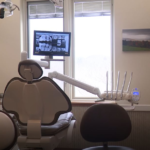
BURLINGTON, Vt. (WCAX) – Artificial intelligence is no longer just a concept, but a real technology being implemented in many facets of life. One sector starting to use AI in Vermont is dentistry.
The Vermont State Dental Society says different forms of AI are becoming more common in everyday dentist practice.
At Stowe Family Dentistry, patients leave understanding more about their teeth than before.
“It answered a lot of the questions that we have on a daily basis in the office trying to explain what X-rays are, which part is the gray part, which part is the darker gray part, you know, trying to differentiate between what’s important and what’s not,” said Dr. John Hirce of Stowe Family Dentistry.
That’s because dentists John Hirce and Jitka Matherly use Pearl – an AI software that highlights decay and infections from X-rays – as part of their routine. They say it helps patients see problem spots more easily and provides another opinion when considering diagnoses.
“As providers, we’re trained to see all this stuff, you know, so to be able to communicate more effectively is important,” said Dr. Hirce.
Stowe Family Dentistry recently adopted the software and have used it in every patient room. The dentists say it also helps other members of the office, like hygienists and those at the front desk. However, they emphasize that it’s just one tool and not a replacement.
“I think it’s pretty automatic for us. We’re not going to you know, throw everything we’ve learned in practice for 20 years away because there is a pink color on the screen, but it is helpful,” said Dr. Jitka Matherly of Stowe Family Dentistry.
Justin Hulburt of Vermont State Dental Society agrees, saying AI in dentistry is more centered around diagnostics and X-rays. He also notes AI is being used to sort through records and databases to bring out information, which is more efficient than someone doing so manually. But overall, AI in dentistry is in the infant stages.
“It does not replace clinical judgment of practitioners, because there’s so much more that goes into treating a patient,” said Dr. Hulburt. “We use it in scanning, scanning and restoration design, all that stuff that comes with high-quality treatment. You know, the more information you have, the more information you can use to design restorations and all that.”
Hulburt also directs UVM’s dental residency program. He says as technology evolves, education does too, and residents are exposed to scanning, restoration, and design AI technology.
Dr. Hulburt said, “Probably like anything as a profession, we’re cautiously optimistic – but love the help that it can give us and how it can change patient care.”
The American Dental Association also says AI can be used for treatment planning and data analysis. However, their standards for AI emphasize that clinical decisions are reserved for dentists and that AI developers are transparent about how products are designed and used.
